Catocala of Utah
Catocala unijuga, courtesy of Carroll Rudy,
August 26, 2006, id confirmed by Larry Gall.
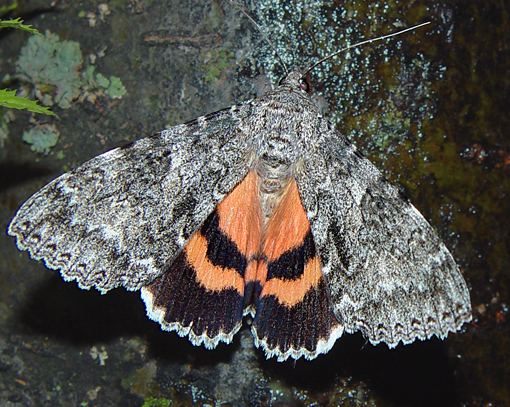
Catocala unijuga, courtesy of Carroll Rudy,
August 26, 2006, id confirmed by Larry Gall.
http://www.utahlepsociety.org/utmothchecklist.html
WHW represents Wayne H. Whaley as data source.
As of April 4, 2010, this page has been further updated as per research data compiled by Larry Gall.
I would like to continue to refine the listings to county levels so images and data (date, location at least to county level,
bait, lights) would be very much appreciated. Please send same to Bill Oehlke.
All images that I use on my websites remain the property of respective photographers and images are credited as such.
The Identification Keys Diagram should help you understand the terminology I have used in describing the various species.
Visit Utah Sphingidae: Hawk Moths/Sphinx Moths.
|
|
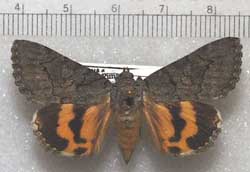
| Catocala chelidonia WHW; 45-50mm. Fw fuscous grey. Reniform, subreniform spots concolourous, with srf closed, sometimes lighter and brown. Pm line thin, distinct, two upper teeth slightly produced. Hw orangish. Black median band swollen near cell, angles 90 d toward, not to im. Fringes off-white opp. orange, grey opp. outer band. Some orange near apex inside thin, distinct sm line. |
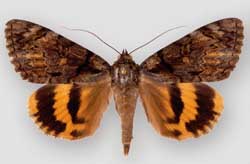
| Catocala delilah; WHW; 60-65mm.The yellow hindwing apical patch is large. The black median band turns in toward the inner margin and alsmost reaches it. The black marginal band is continuous, but in some specimens is nearly broken near the anal angle. |
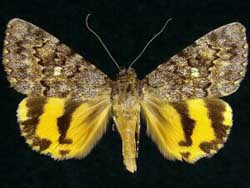
| Catocala benjamini; 50 mm. Catocala benjamini reportedly flies as nominate susbspecies in Arizona, Nevada, southern California, southern Utah. Catocala benjamini mayhewi flies in southern California. Catocala benjamini jumpi flies in Kofa Mountains of Arizona. Catocala benjamini ute flies in southeastern Utah in Balaneed Rock Area at elevations around 1610 m. |
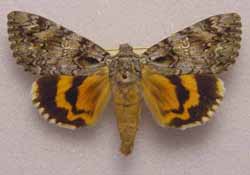
| Catocala ilia zoe RFR; 65mm. unconfirmed Fw light grey, considerable brown scaling. Double reniform spot has brown center, thinly outlined in black, widely outlined in white, then thinly outlined in black. Subreniform spot indented on both inner & outer side, just above its tailed extension, which may/ may not be open. Aml black, distinct, pointed, triangular shaped indentation just above im. Pm line darker along upper half. southern and western. |
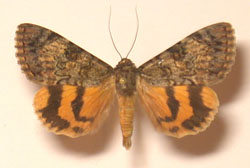
| Catocala desdemona RFR; 55-70mm. Fw gc is light mottled grey with greenish blue cast. Double reniform spot brown. Subreniform spot large, lighter brown, closed; tail extends to pm line. Upper pml teeth moderately produced, next two teeth, not at all. Next produced, thick, rounded, distinct inward loop below. Hw ib turns 90 toward im. Ob broken; large orange apical area. |
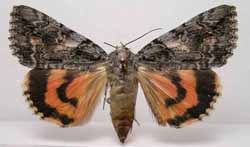
| verrilliana; Verrill's Underwing K-P; 45-60mm. Closed, subtriangular subreniform spot large, light in colour. Light patch runs from subreniform diagonally to costa. Dark area on basal side of aml, light patches between pml and subterminal line distinguish this species. Note orange hw fringe. July-September, oaks. |
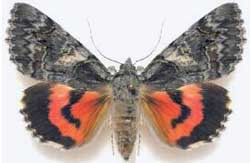
| Catocala ophelia RFR ; Ophelia Underwing: 52mm: Fw dark grey, am/pm lines relatively smooth except for two jagged spikes in pm near apex. Considerable brown shading outside subterminal line. Hw pink-deep red, black median band constricted in center, ending before im. Black submarginal border is quite broad near apex. White fringe heavily checked. Southwestern |
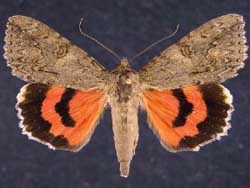
|
faustina K-P;
58 mm |
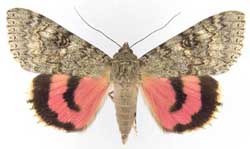
| Catocala hermia K-P; Hermia Underwing: 58-68mm; pinkish: Fw uniform, grey-brown/clay coloured, thin, contrasting medial lines. Distinct large double reniform spot. Large concolourous subrenifrom spot usually open. Hw pinkish red, relatively even, narrow black bands. Inner band ends before im. Fringe white, checked, "bleeding" along outer band, near apex. |
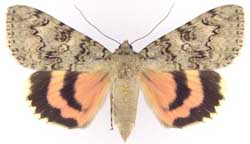
| ** 8808 luciana; Luciana Underwing; 57-70mm. Luciana has pale grey brown fw with very distinct am & pm lines. Subreniform spot has elongated narrow "tail" that seems to open through postmedial line. Hw inner black band does not reach inner margin. Fringe is checked and paler (almost yellow) than salmon ground colour. |
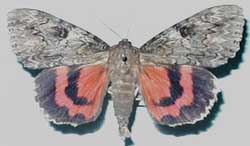
| irene; Irene's Underwing WHW; 65-75mm. Fw grey brown, darker upper half basal area, around reniform spot, indistinct arc near apex. Sbrnfrm spot lighter, open into pm area. Hw median black band pointed before reaching im. Outer band scalloped near a. a.. Probably southeast; poplars, willows |
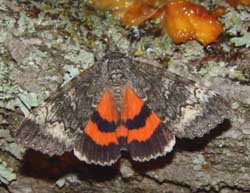
| #8817 briseis, WHW; Briseis Underwing; 60-70mm: Fws predominantly mottled dark-grey-brown with some lighter areas between pm and subterminal lines, at base of am and pm lines along im, and over subreniform spot running diagonally toward costa. Pm lines lack greatly elongated and sharly pointed "teeth" near apex. Hw fringe white, unbroken; inner black band (fairly even) reaches ima. July-September, probably northern only; willows and poplars |
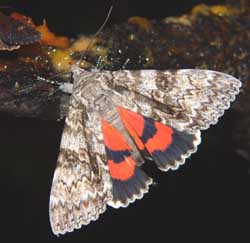
| ** 8821
semirelicta; Semirelict Underwing, WHW;
65-75mm |
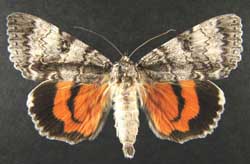
| 8823 Catocala semirelicta hippolyta 98L; Hippolyta Underwing; 72-76mm:Catocala hippolyta, Catocala nevadensis and Catocala pura might all be synonymous with Catocala semirelicta. I do not know for sure. If they are different. Note very thin hindwing median band in image to left. |
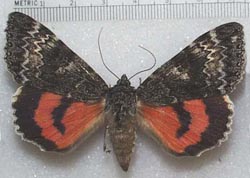
| Catocala grotiana K-P; Grote's Underwing: 70-80mm: The white outlines outside the postmedial and inside the subterminal lines make this species stand out. The hindwing inner black band is even and relatively thin and terminates well before the inner margin. The fringe is heavily checked and charcoal grey along the inner margin. Hindwings can be orange or red. August until September; willows |
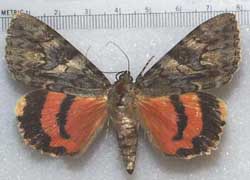
| Catocala jessica WHW; Jessica Underwing: 75mm: Fw is bluish grey with some brown scaling. Am line is irregular, meets i m almost at midpoint. Pm line has one upper tooth produced, second is much less so. Third is little more than a sharp point on smooth curve to fourth tooth, somewhat produced over opening of large subreniform spot. Reniform spot is double and dark in darker region of median area. |
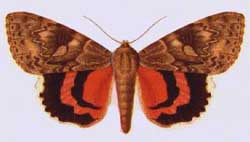
| Catocala electilis K-P; Fw dark grey. Black pm line thin but distinct; two upper teeth not greatly produced. Reniform spot dark brown; large, pork-chop shaped subreniform spot lighter brown extends to pm line. Brown shading in subterminal area. Hw salmon (orange to red). |
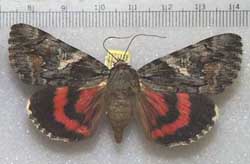
| ** 8833 violenta Violent Underwing (70-80mm): Two elongated, well-defined spikes high in the postmedial line extend to subterminal line. Next tooth is very short. There is considerable brown shading on the forewing between the pme and st lines. Subreniform spot is light with light bar extending obliquely to the costa. |
Large Orange-Salmon Underwings: Wingspans: 75mm and larger
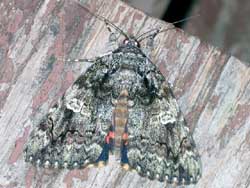
| ** 8801 Catocala ilia; Ilia; wingspan: 65-82mm. unconfirmed Several different forms, most have characteristic white area in and around reniform spot. Diffuse dark arc running from this spot to just below apex. Subreniform spot squarish, concave inner and outer edges and elongated constriction connecting it to pml. White dots near fw om in character with the overall "contrasting" appearance. |
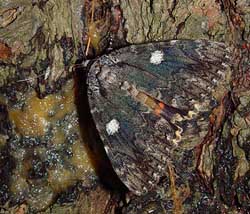
| ** 8801 Catocala ilia; Ilia; form conspicuaIn this form the entire reniform spot is heavily suffused with white scaling on an otherwise darker ground colour. Hence the form name "conspicua". Tim Dyson image. |
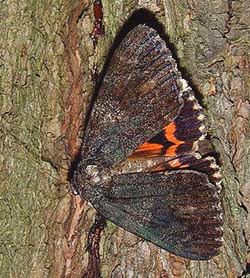
| ** 8801 Catocala ilia; Ilia; form satanasIn this melanic form the entire forewing, including the reniform spot is very dark. Hence the form name "satanas". The dark basal streak is still evident on this form. Tim Dyson image. |
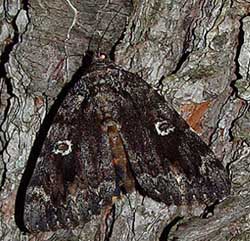
| ** 8801 Catocala ilia; Ilia; form normani In this semi-melanic form the entire forewing, excluding the reniform spot, is relatively dark. The brownish, kidney-shaped center of the reniform spot is outlined in white. The basal streak and subapical arc are still visible. July until September, probably southeast; oaks. |
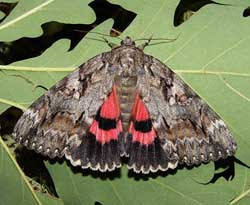
| aholibah K-P; 80-90mm: Fw is mix of grey and brown, with preponderance of brown in subterminal area. Double reniform spot has diffuse brown outline of inner oval. Subreniform spot is small, distinctly outlined in black, light coloured and does not connect to pm line. Upper two teeth of pm line are elongate and are followed by relatively smooth line til next tooth below the subreniform spot. Hindwing salmon or pinkish. |
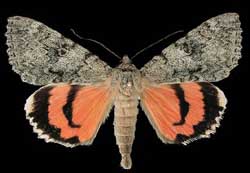
| Catocala junctura WHW; Joined Underwing; 67-85mm. Fw usually dark brownish-gray to evenly powdered blue-grey w/o significant markings. Doubled reniform spot often obscure. Thin, slightly darker am/pm lines run from costa to im, not widely spaced at im. Hw salmon/orange-pink, narrow inner black band turns in sharply, does not meet dark-haired im. May until October; poplars; willows |
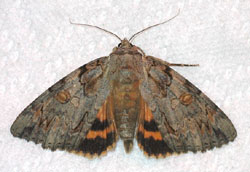
| ** 8798 Catocala neogama; wingspan 70-85mm. Brown head, thorax, larger compared to C. palaeogama. Neogama tend to be slightly smaller than subnata, have darker grey brown fws with more pronounced markings. Examination of hind tibia needed for id. Neogama's: flattened, unevenly, sparsely spined; subnata's: cylindrical, spines dense, uniform in distribution. |
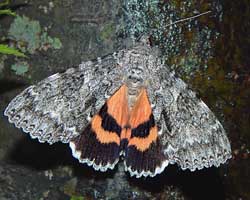
| ** 8805 unijuga; Once-married; wingspan: 70-90mm: Fairly wide black inner band (almost reaching inner margin) in hw; very distinctive patterning in fw. Meskei tend to have narrower band; dustier (less distinct) looking fw. Semirelicta tend to have inner bands that terminate well before inner margins. Also note very white fringe on both forewings/hindwings. |
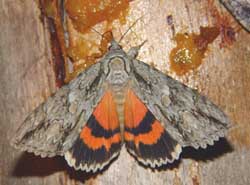
| ** 8806 Catocala parta, WHW;
Mother Underwing, wingspan: 70-85mm |
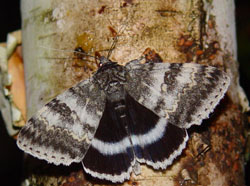
| ** 8803 Catocala relicta WHW; Forsaken, White, Relict; 70-80mm: Considerable variation with regard to black/white concentrations on fws. Typical specimens have basal and subterminal areas with blackish scales. Black hws, with brilliant even white inner band; white fringe, are distinctive. June-October, probably N.& E; poplars; willows |
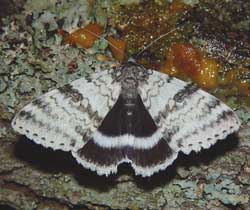
| ** 8803 Catocala relicta ; Forsaken, White, Relict; 70-80mm: Form clara: basal and subterminal areas predominantly white. Typical specimens have basal and subterminal areas with blackish scales. Black hws, with brilliant even white inner band and white fringe, are distinctive. June until October, probably N.& E; poplars and willows |
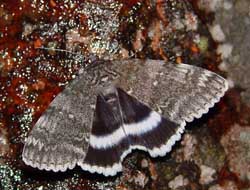
| ** 8803 Catocala relicta; Forsaken, White, Relict; 70-80mm: Form phrynia: evenly dusted with grey over entire forewing. Typical specimens have basal and subterminal areas with blackish scales. Black hws, with brilliant even white inner band and white fringe, are distinctive. June until October, probably N.& E; poplars and willows |
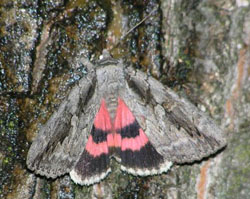
|
** 8834 amatrix Sweetheart Underwing; (wingspan 75-95mm). Very skittish, frequently hides in caves, under bridges, under tree bark, etc. by day, resting with head down. Hw patterning and colouration similar to that of C. concumbens, but large size (wingspan 75-95mm) and dark bar running from basal area to just below apex distinguishes C. amatrix. |
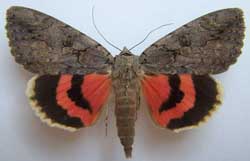
|
** 8834 amatrix form selecta
Sweetheart Underwing; (wingspan 75-95mm) |
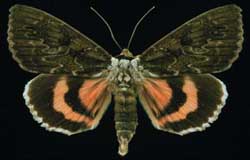
|
** 8834 amatrix form hesseli
Sweetheart Underwing; (wingspan 75-95mm) |
Use your browser "Back" button to return to the previous page.
Return to Canadian Index
Return to Main Index
Enjoy some of nature's wonderments, giant silk moth cocoons. These cocoons are for sale winter and fall. Beautiful Saturniidae moths will emerge the following spring and summer. Read Actias luna rearing article. Additional online help available.
Eggs of many North American Saturniidae species are offered during the spring and summer. Occasionally summer Actias luna and summer Antheraea polyphemus cocoons are available. Shipping to US destinations is done from within the US.
This page is brought to you by Bill Oehlke and the WLSS. Pages are on space rented from Bizland. If you would like to become a "Patron of the Catocala Site", contact Bill.
Please send sightings/images to Bill. I will do my best to respond to requests for identification help.

|
butterfly to the left, a link to many worldwide insect sites. |